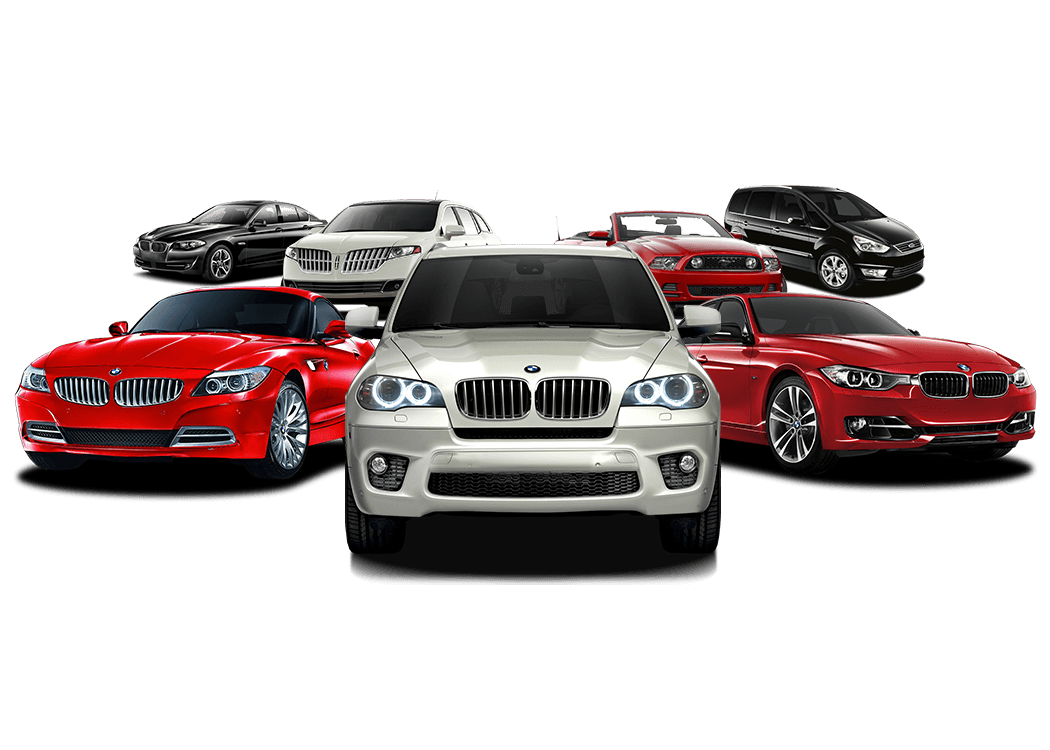Pricing and Production[]
The car debuted with a factory MSRP of around $400,000, although some buyers were reported as paying as much as $1.6 million dollars for their F40 in the early 90’s supercar boom. Today, prices usually hover around the $300,000 mark to $450,000 for cleaner examples. The resale value is lower than that of other Ferrari supercars because of the large production numbers of the F40. As a result of that and being made available to anybody, whom many brought the car purely as an investment at the time. Ferrari, onward in order to deter investors, only invited loyal customers, later to change that to a requirement of buying two brand new models from its showrooms, to buy their future supercars with a contract tied to it to prevent a quick resale and would learn its lesson by refusing to produce over the initial amount.
Проблемы и надежность МКПП Opel F40
Механическая коробка передач Opel F40 – это 6-ступенчатая трехвальная трансмиссия, рассчитанная на передачу крутящего момента до 400 Нм. Ее устанавливали на автомобили Opel с 2004 года в паре с дизельными моторами объемом от 1,6 до 3,0 литров, а также с бензиновыми турбомоторами объемом 2,0 и 2,8 литра. Также отметим, что коробка F40 используется только с двухмассовым маховиком. 4-я передача в коробке F40 – прямая, т.е. с передаточным числом около 1. 5- и 6-я передачи – повышающие.
Применение коробки F40 началось еще на моделях Vectra C и Signum и продолжается до сих пор, например, на Insignia 2-го поколения. На кроссоверах Antara и Captiva коробка используется с полным приводом и имеет значительные отличия в корпусе под крепления раздаточного редуктора.
Помимо автомобилей Opel коробку F40 устанавливали на соплатформенные модели от Saab и Buick. Также на автомобили Alfa Romeo 156, 159, 166 и Brera, Fiat Bravo и Lancia Thesis и Delta c дизелями 1,9 и 2,4 JTD.
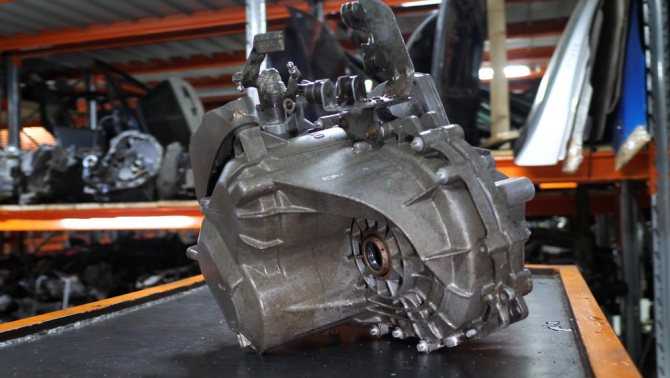
На нашем YouTube-канале вы можете посмотреть разборку коробки F40, с Opel Vectra C 1.9 CDTi.
Выбрать и купить механическую 6-ст. коробку передач для автомобиля Opel, 6-ст. МКПП для Saab или МКПП для Alfa Romeo вы можете в нашем каталоге контрактных коробок передач.
Идентификация коробки F40
Коробки F40 отличаются между собой по передаточным числам, всего существует около 7 версий. Варианты под дизельные и бензиновые двигатели отличаются диапазоном передаточных чисел. Для дизелей диапазон шире: с более длинной 1-й передачей и короткой 6-й. Коробки F40 для кроссоверов отличаются самой короткой первой передачей: передаточное число больше 4,1.
Похожая картина и с передаточными числами дифференциалов: наименьшие передаточные числа (до 3,3 и даже 3,1) у дифференциалов для дизелей, а самые большие (до 3,8 и 4,1) – под бензиновые двигатели. Конкретный набор передаточных чисел и даже ее предназначение к конкретному двигателю и модели автомобиля зашифрован в последних 2- или 3-х символах индекса коробки (выбиты после дефиса).
Надежность коробки F40
Коробка передач F40 в целом надежная и беспроблемная, практически никогда она не создает проблем. Однако поломки случаются. Причем, если коробка F40 сломается, то сразу капитально.
Дело в том, что на мощных двигателях бывают случаи срезания шестерен высоких передач – 3-й, 4- или 5- в момент резкого переключения на них с другой более высокой передачи. Разумеется, в этом случае передача пропадает. Срезанные зубья просто осыпаются на «дно» корпуса МКПП и не попадают между другими шестернями.
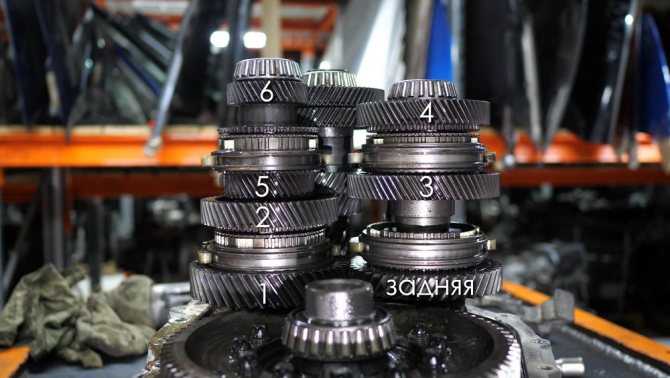
В 2011-2013 годах на автомобилях Opel Astra J OPC коробку F40 довольно часто меняли по гарантии из-за пропадания второй передачи или ее выбивания во время движения и добавления скорости. Эта проблема поялялась из-за разрушения ее синхронизаторов. Считается, что проблемные коробки сошли с конвейера с недостаточным количеством масла, что и вызывало «поломку» второй передачи.
Также в довольно редких случаях на коробках F40 наблюдаются течи сальника первичного вала и даже износ подшипника первичного вала.
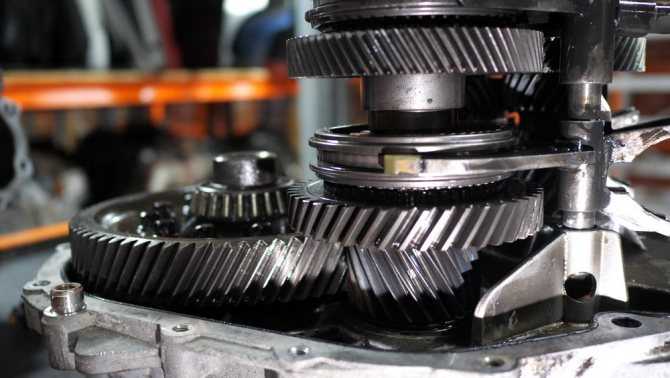
Масло для МКПП F40
Производитель не регламентирует замену масла в коробке F40, но менять его стоит каждые 50 000 км. Фирменное масло GM (1940182) стоит примерно по $12 за литр, в коробку F40 входит 3,2 литра масла. Трансмиссионная жидкость сливается очень просто, а для того, чтобы добраться до заливной пробки, нужно снимать АКБ и его площадку и заливать масло через лейку с длинной трубкой.
Выбрать и купить коробку передач для Опель или коробку передач для Альфа Ромео вы можете в нашем каталоге контрактных коробок передач.
Здесь по ссылкам вы можете посмотреть наличие на авторазборке конкретных автомобилей Opel заказать с них автозапчасти.
Соревнование
| Феррари F40 LM | |
| Ferrari F40 LM # 40 команды Taisan Starcard | |
| отметка | Феррари |
|---|---|
| Годы производства | — 1998 гг. |
| Учебный класс | Гоночный автомобиль |
| Двигатель и трансмиссия | |
| Энергия | Бензин |
| Мотор (ы) |
90 ° Biturbo V8 |
| Положение двигателя | Продольный центральный задний |
| Смещение | 2 936 см 3 |
| Максимальная мощность | От 760 до 780 л.с. (от 567 до 582 кВт ) |
| Максимальный крутящий момент | ~ 700 Нм |
| Передача инфекции | Движение |
| Коробка передач | 5 или 6 МКПП |
| Вес и производительность | |
| Вес без патронов | От 1050 до 1225 кг |
| Максимальная скорость | 370 км / ч |
| Ускорение | От 0 до 100 км / ч за 3,5 с |
| Шасси — Кузов | |
| Кузовные работы) | 2-дверное купе |
| Рамка | Карбоновый корпус |
| Подвески | Спереди: двойные поперечные рычаги и регулируемый стабилизатор поперечной устойчивости AR: регулируемый стабилизатор поперечной устойчивости |
| Направление | Зубчатое колесо |
| Тормоза | Дисковые вентилируемые 355 мм |
| Габаритные размеры | |
| Длина | 4535 мм |
| Ширина | 1,980 мм |
| Колесная база | 2450 мм |
Ferrari F40 доступен в нескольких гоночных версиях :
- 1989: F40 Valeo, 1 копия, для генерального директора Fiat-Ferrari Джанни Аньелли , с электронным сцеплением Valeo (срабатывающим менее чем за 100 миллисекунд), автоматически управляемым рычагом переключения передач, первоначально разработанным для раллийных автомобилей Lancia Delta Integrale.
- С 1989 по 1998 год: F40 LM и LM IMSA, ( Ле-Ман ), около десяти экземпляров, подготовленных Michelotto Automobili , доведенных до 900 лошадиных сил, для 24 часов Ле-Мана , чемпионата IMSA GT (класс GTO).
Исторический
В 1984 году, по инициативе Никола Матерацци, Энцо Феррари запустил программу изучения Ferrari 288 GTO «Evoluzione» , чтобы составить конкуренцию Porsche 959 в группе B , а также отметить и отметить 40-летие со дня основания. его компании.
На самом деле, Никола Матерацци объясняет, что он предложил Энцо Феррари модифицировать 288 GTO, чтобы сделать автомобиль, на котором клиенты могли бы участвовать в гонках. Энцо Феррари не смог дать своего одобрения, это касалось серийных автомобилей. Затем Никола Матерацци вызвал Эухенио Альзати, генерального менеджера по производству автомобилей серии Ferrari (человек Fiat), который одобрил запрос. Тем не менее, он потребовал, чтобы автомобиль был разработан в субботу утром, чтобы не нарушать текущее производство.
В 1987 году, наряду с Ferrari Testarossa 1984 года, бренд представил этот суперкар GT ограниченной серии. На тот момент это был самый эффективный и экономичный спортивный автомобиль в истории автомобилестроения , вдохновленный соревнованиями и, в частности, Формулой-1 . Автомобиль был представлен прессе 21 июля 1987 года на автодроме Фьорано на заводе Ferrari в Маранелло самим Энцо Феррари вместе с Леонардо Фиораванти (главный дизайнер) и Питером Камарделлой. Презентация для широкой публики состоится на автосалоне во Франкфурте в том же году.
Согласно личной философии всей жизни и последним пожеланиям комендатора Энцо Феррари (1898-1988), это последняя модель суперкара GT Ferrari, которая раздвинула границы « оптимального автомобильного машиностроения », не прибегая к первым решениям. о технической помощи и вспомогательных средств популярного в мире автомобильного дизайна в то время. F40 — первый дорожный автомобиль в истории Ferrari, построенный из различных композитных материалов, таких как кевлар. На момент презентации это был самый быстрый серийный автомобиль из когда-либо построенных с проверенными 324 км / ч.
Это был последний Ferrari, оснащенный двигателем с турбонаддувом, построенный под руководством Энцо Феррари.
Первоначально планировалось продать серию из 400 экземпляров в очень короткие сроки, затем производство было увеличено до 1000 экземпляров. Когда ценность автомобиля достигла новых высот, в то же время он получил сертификацию в США, от которой до тех пор отказывали из-за его экстремальных характеристик. Феррари была вынуждена соблюдать контракт с американским импортером, который обязывал фирму Маранелло выделять 22% производства каждой модели на американский рынок. Поэтому производство было снова увеличено в последний раз, чтобы довести общее количество выпущенных F40 до 1337 экземпляров. Эта ограниченная серия и исчезновение Энцо Феррари в следующем году в возрасте 90 лет вызвали спекуляции с новыми F40, проданными более чем за 5 миллионов франков , что намного выше заводской цены.
На смену ему в 1995 году пришел конкурент Porsche 959 , Lamborghini Diablo , Jaguar XJ220 , Bugatti EB110 , Ferrari F50 .
F40 US Patent For Ornamental Design[]
- Number: D306,274
- Date of Patent: February 27, 1990
- Terms: 14 Years; IAW Manual of Patent Examining Procedure (MPEP) Chapter 1500, Section 1505 Allowance and Term of Design Patent & 35 U.S.C. 173 Term of design patent. Patents for designs shall be granted for the term of fourteen years from the date of grant.
- Expired: Yes
- Renewable: No
- Amendments: None however if there is, it will not renew or extend the terms of patent; IAW MPEP Ch. 1500 Sec. 1509 Reissue of a Design Patent
The term of a design patent may not be extended by reissue. Ex parte Lawrence, 70 USPQ 326 (Comm’r Pat. 1946).
Copyright/Trademark: None at the time of patent. Since inventor of the ornamental design (Leonardo Fioravanti) is not from Ferrari S.p.A. but rather from Pininfarina S.p.A..
Performance[]
The F40’s light weight of 1100 kg and high power output of 478 hp @ 7000 rpm gave the vehicle tremendous performance potential. Road tests have produced 0-60 times as low as 3.5 seconds, with 0-100mph in 7.6 seconds, giving the F40 a slight advantage in acceleration over the 959, which was considered its primary competitor at the time. From its introduction in 1987 until 1989, it held the record as the world’s fastest production car, with an unofficial top speed of 201 mph; the record was broken by the RUF CTR «Yellowbird», owing to the RUF’s 211 mile-per-hour top speed — although the F40 could still outrun it to sixty. The top speed was publicly proven capable of its rated top speed in 1992 through an infamous incident in which a Japanese dealership owner proved the car’s potential by filming himself touching its top speed on a expressway only to be arrested after he sold a videotape to a undercover policeman. By that time, he already sold ten thousand videos.
F40 Specifications
| model | 1989 Ferrari F40 |
| type | Series Production Car |
| built at | Modena, Italy |
| price £/td> | £200,000 |
| engine | V8 |
| position | Mid Longitudinal |
| aspiration | Natura |
| valvetrain | DOHC 4 Valves / Cyl |
| displacement | 2936 cc / 179.2 in³ |
| bore | 82.0 mm / 3.23 in |
| stroke | 69.5 mm / 2.74 in |
| compression | 7.8:1 |
| power | 356.5 kw / 478 bhp @ 7000 rpm |
| specific output | 162.81 bhp per litre |
| bhp/weight | 387.04 bhp per tonne |
| torque | 576.2 NM / 425.0 ft lbs @ 4000 rpm |
| redline | 7750 rpm |
| body / frame | Composite Body over Steel Frame |
| driven wheels | RWD |
| front tires | F 235/45ZR-17 |
| rear tires | R 335/35ZR-17 |
| front brakes | Vented Discs w/Vacuum Assist |
| rear brakes | Vented Discs w/Vacuum Assist |
| front wheels | F 43.2 x 20.3 cm / 17.0 x 8.0 in |
| rear wheels | R 43.2 x 33.0 cm / 17.0 x 13.0 in |
| steering | Rack & Pinion |
| curb weight | 1235 kg / 2723 lbs |
| wheelbase | 2450 mm / 96.5 in |
| front track | 1595 mm / 62.8 in |
| rear track | 1610 mm / 63.4 in |
| length | 4430 mm / 174.4 in |
| width | 1980 mm / 78.0 in |
| height | 1130 mm / 44.5 in |
| transmission | 5-Speed Manual |
| gear ratios | 2.77:1, 1.71:1, 1.23:1, 0.96:1, 0.77:1 |
| final drive | 2.90:1 |
| top speed (Mfr. quoted) | ~324 kph / 201.3 mph |
| 0 – 60 mph (Mfr. quoted) | ~3.8 seconds |
| 0 – 100 mph (Mfr. quoted) | ~8.0 seconds |
| 0 – 1/4 mile (Mfr. quoted) | ~11.8 seconds |
Экстерьер и интерьер
Об этой красоте можно говорить часами, но страница не резиновая и когда-нибудь придется остановиться. Не побоюсь этого слова – Ferrari Ф40 выглядит очень амбициозно и статус культового суперкара она заслужила. Чего стоит только невероятно красивый кузов, разработанный в ателье Pininfarina. Он был изготовлен из карбонового волокна, алюминия и кевлара. Но это лишь маленькая часть всего, что так пленит любого автолюбителя.
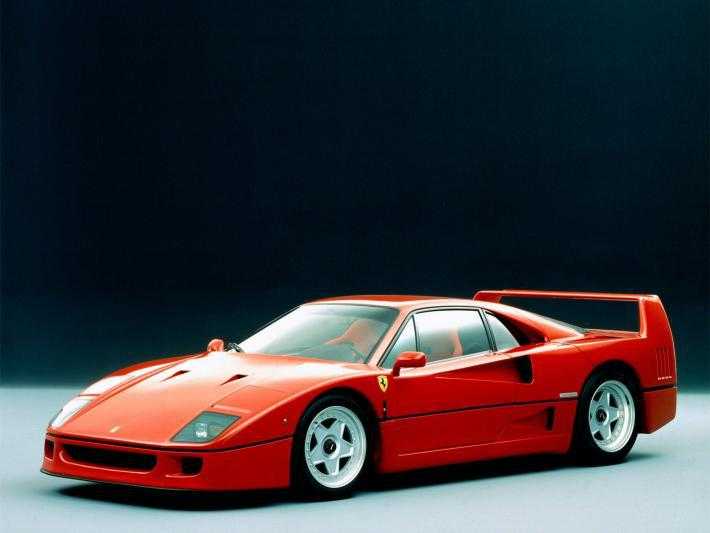
Дизайнеру Леонардо Фиораванти удалось создать воистину неописуемое словами сочетание гармонии линий, пластики и грубости, агрессии и нежности, легкости и строгости. Эти черты присущи всем автомобилям Феррари. Как бы смешно это не звучало, но дизайнеры и тут скопировали много наработок с того же Ferrari GTO.
Единственное, что так сильно выделяло Ferrari Ф40 с толпы других гоночных авто – агрессивное оперение. Благодаря ему автомобиль даже за километр нельзя было спутать ни с чем. В плане аэродинамики – кузов оказался настоящей сказкой, а коэффициент лобового сопротивления не превышал 0,34. В общем, было чему позавидовать конкурентам.
Касательно шасси – роскошная оправа и грубый стиль сделали свой вклад в идеальный стиль авто. Во франкфуртском автосалоне при первом появлении данного детища ценители находились в полном экстазе и словно пожирали аппетитную «фигуру» модели. Многих даже не смутила стартовая цена данного автомобиля. Стекла Ferrari F40 сделаны из пластика, что добавило ему легкости.
Внутренняя часть автомобиля тоже не дала пройти себя стороной благодаря чрезвычайно удобному сидению и легкому движению руля. Создается впечатление, что руль сделан именно под вас. Впрочем, это надо чувствовать, а чувствовать тут, уж поверьте, есть что. Конечно ковры, акустика и прочая атрибутика для удобств отсутствовала в заводской комплектации.
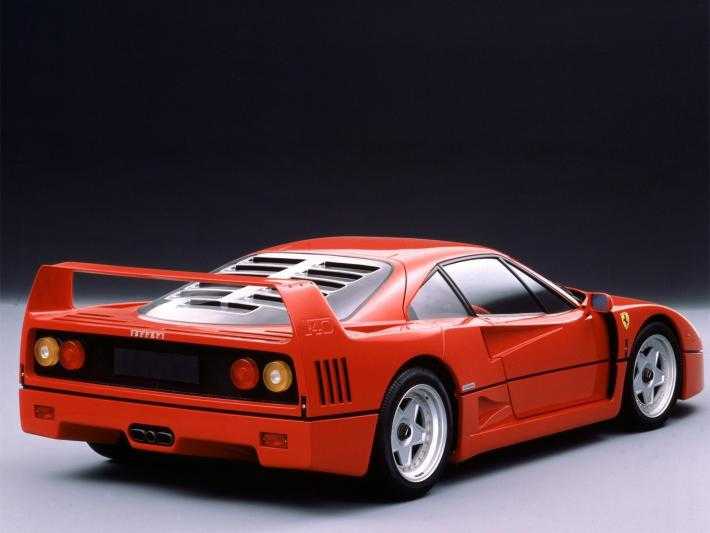
Технические характеристики
Мотор
Двигатель F120D унаследовал 400-сильную версию Evoluzione предыдущего Ferrari 288 GTO , унаследованную от серии Scuderia Ferrari соревнований Dino и двигателей V6 и V8 Формулы 1 .
90 ° V8 , с 3 литра перемещения (2936 см 3 ), расположен в продольном направлении. Он оснащен двумя турбокомпрессорами IHI с промежуточным охладителем мощностью 478 лошадиных сил. Это позволяет F40 разгоняться от 0 до 100 км / ч за 3,9 секунды и 1000 м с места за 21,8 секунды при максимальной скорости 324 км / ч . Он имеет двойной верхний распределительный вал на ряд цилиндров и 32 клапана (четыре клапана и две форсунки на цилиндр). Картер, блок цилиндров и головки цилиндров выполнены из силумина ( алюминий — кремний сплава ). Внутренние стенки алюминиевых гильз усилены гальваническим слоем никасила ( никелевый сплав — карбид кремния ) для снижения коэффициентов трения и улучшения смазки и устойчивости к высоким температурам.
Никола Матерацци сообщает, что в отношении выбора турбин было организовано сравнительное испытание на ускорение между F40, оснащенным турбинами марки IHI, и другим автомобилем, получающим турбины KKK, в присутствии президента компании KKK. Энцо Феррари присутствовал во время этого теста. В конце теста президент фирмы KKK признал, что японские турбины IHI лучше.
Передачи являются ручной 5-ступенчатым, плюс обратной, с продольно установлены сухим сцеплением двойного диска. Он был разработан Никола Матерацци специально для работы с крутящим моментом 577 Н · м. ZF , обычный поставщик коробок передач Ferrari, в то время не имел подходящей коробки передач, которая могла бы выдерживать такие значения крутящего момента. Коробка передач ZF могла выдерживать только 40 мкг (~ 392 Н · м) крутящего момента.
Тело
Двухместный берлинет на стальной трубчатой раме с внутренними панелями кабины, усиленными кевларом и углеродным волокном, пропитанным эпоксидной смолой. Одна только обрешетка из стекловолокна весит всего 46 кг. Передняя и задняя подвески независимые, либо поперечные рычаги с винтовыми пружинами и стабилизатора поперечной устойчивости. Благодаря масляно-пневматическим амортизаторам, регулируемым из кабины, подвески можно отрегулировать на три различных уровня по высоте и жесткости в зависимости от стиля вождения и условий эксплуатации. Колесная база составляет 2450 мм, передняя колея — 1594 мм, а задняя — 1606 мм. Управление зубчатое. Общий вес 1155 кг. Никола Матерацци уточняет, что первый F40 весил 1093 кг; эстетические изменения утяжелили серийную модель.
Инженер Мауро Форгьери сказал: «Я думал, что это автомобиль с шинами меньшего размера для той мощности, которую он имел. Линия, которую желала Pininfarina, сильно ограничивала размер задних шин».
Интерьер
Интерьер F40 сведен к минимуму, поскольку его призвание больше гоночного, чем дорожного. За исключением опционального кондиционера, аудиосистема, перчаточный ящик, ковровое покрытие, кожаная отделка и дверные панели отсутствуют. Первые 50 моделей использовали раздвижные боковые окна, в то время как последние были оснащены опускающимися лицевыми панелями; ни одной модели с окнами с электроприводом не выпускалось. Внутренние дверные ручки заменены на резиновые накладки. У F40 нет гидроусилителя руля и АБС. Эта «спартанская» одаренность еще больше отличает его от его конкурента Porsche 959, который хвастался широким использованием электронных технологий.
использованная литература
- ↑ и
- (оно) , Ferrari ,21 июля 2017 г.
- ↑ и
|
Хронология дорожных моделей Ferrari с 1960 года до наших дней |
||||||||||||||||||||||||||||||||||||||||||||||||||||||||||||||||||||||||||||||||||||||||||||||||||||||||||||||||||||||||||||||||||||||||||||||||||||||||||||||||||||||||||||||||||||||||||||||||||||||||||||||||||||||||||||
|---|---|---|---|---|---|---|---|---|---|---|---|---|---|---|---|---|---|---|---|---|---|---|---|---|---|---|---|---|---|---|---|---|---|---|---|---|---|---|---|---|---|---|---|---|---|---|---|---|---|---|---|---|---|---|---|---|---|---|---|---|---|---|---|---|---|---|---|---|---|---|---|---|---|---|---|---|---|---|---|---|---|---|---|---|---|---|---|---|---|---|---|---|---|---|---|---|---|---|---|---|---|---|---|---|---|---|---|---|---|---|---|---|---|---|---|---|---|---|---|---|---|---|---|---|---|---|---|---|---|---|---|---|---|---|---|---|---|---|---|---|---|---|---|---|---|---|---|---|---|---|---|---|---|---|---|---|---|---|---|---|---|---|---|---|---|---|---|---|---|---|---|---|---|---|---|---|---|---|---|---|---|---|---|---|---|---|---|---|---|---|---|---|---|---|---|---|---|---|---|---|---|---|---|---|---|---|---|---|---|---|---|---|---|---|---|---|---|---|---|---|
|
||||||||||||||||||||||||||||||||||||||||||||||||||||||||||||||||||||||||||||||||||||||||||||||||||||||||||||||||||||||||||||||||||||||||||||||||||||||||||||||||||||||||||||||||||||||||||||||||||||||||||||||||||||||||||||
| Прототипы | 250 P5 Berlinetta Speciale · 250 P6 · 365 Special P · 599XX · Aurea · Dino 246 GT / GTS · FXX · Modulo · Mythos · P4 / 5 · Pinin · Rossa · GG50 · Dino Berlinetta Speciale · FXX K |
Racing[]
File:Goodwood2007-025 Ferrari F40 LM (1995).jpg
An F40 LM on display at the Goodwood Festival of Speed
The factory never intended to race the F40, but the car saw competition as early as 1989 when it debuted in the Laguna Seca Raceway round of the IMSA, appearing in the GTO category, with a LM evolution model driven by Jean Alesi, finishing third to the two faster spaceframed four wheel drive Audi 90 and beating a host of other factory backed spaceframe specials that dominated the races. Despite lack of factory backing, the car would soon have another successful season there under a host of guest drivers such as Jean-Pierre Jabouille, Jacques Laffite and Hurley Haywood taking a total of three second places and one third.
Although the F40 would not return to IMSA for the following season, it would later be a popular choice by privateers to compete in numerous domestic GT series including JGTC. In 1994, the car made its debut in international competitions, with one car campaigned in the BPR Global GT Series by Strandell, winning at the 4 Hours of Vallelunga.
In 1995, the number of F40s climbed to four, developed independently by Pilot-Aldix Racing (F40 LM) and Strandell (F40 GTE, racing under the Ferrari Club Italia banner), winning the 4 Hours of Anderstorp. No longer competitive against the McLaren F1 GTR, the Ferrari F40 returned for another year in 1996, managing to repeat the previous year’s Anderstorp win, and from then on it was no longer seen in GT racing.
Competizione
The F40 Competizione is a non-sponsored, more powerful version of the F40 LM cars that were being raced, which was the result of consumer requests following the order of a French importer who wanted to enter one in the 24 Hours of Le Mans. 10 examples were built, the first two being called F40 LM’s, and the remaining 8 being F40 Competizione, as Ferrari felt that the LM tag was too restrictive.
A F40 Competizione can be found today in the Automobile Museum of Turin.
Succession
The F40 was discontinued in 1992, and in 1995 the F50 was intended to be its successor in GT1 racing; but only three racing F50s were produced and none ever actually competed in a race.
Class success and name contiuning
As the best car ever produced by Ferrari until 1995, the F40 was really successful and sold over 1000 units. The «F40» name was modified in 1995 to «F50», with a completely different body and engine (it was a V12, rather than V8). But despite of only 349 built, F50 and it’s predecessor were one of the best cars in the world. The F50 name was disappeared in 1997, replaced by Enzo in 2002 and then Enzo’s production was ended in 2004, and the Enzo was replaced by LaFerrari in 2013. Originally, F50 had no direct successor, but it’s name successor was introduced in 2014, the F60 America, for celebrating 60 years of Ferrari in North America, however, it haves no similarities with the F40 or F50 at appearance.
Critical Response
While Ferrari purists clamored for the F40 from the very beginning, the automotive press was split on their opinions of the car when it was unveiled in 1987. Road & Track Magazine praised the car’s appearance, but many of the other keep publications were unimpressed.
The Ferrari F40 and the Porsche 959 are both the bi-product of the FIA Group B racing class.
One significant criticism that seemed to resound within the automotive community is that Ferrari had built the F40 in an attempt to “cash-in” on enthusiasts after seeing how much money they’d pay for a used Ferrari 288 GTO, as well as the high market demand for the Porsche 959, which was considered to be the F40’s only comparative rival at the time.
In 1988, in an effort to try and sway the opinion of the critics, Ferrari invited journalists to test the Ferrari F40 alongside a Porsche 959 at their home track – the Fiorano Circuit. Car Magazine and Automobile Magazine each published a detailed article comparing the two cars and, while both conceded that the F40 was the faster, more powerful machine, they also agreed that the Porsche 959 was the all-around better car.
Still, there was no denying that the F40 was an unmatched when it came to the numbers. The July, 1988 article written by Georg Kacher and Gavin Green, stated the following about the Ferrari F40:
In a 1990 publication by Motor Trend, author and automotive critic Gordon Murray had the following to say about the car:
Car and Driver Magazine reviewed the car, calling it a “mix of sheer terror and raw excitement.” While they specifically noted that the car’s quick acceleration in first gear was exhilarating, they also acknowledged that the car was “pure terror” when operating it on a busy highway. Rear vision was so bad on the car that lane changes required “leaps of faith”. Ultimately, they found the car unfit for daily road use, making such statements as (the car is) “so mechanically delinquent that an onboard mechanic is advised.”
Despite the critics, the car’s popularity amongst Ferrari enthusiasts and owners remains unshaken until this day. When asked why, especially when even the most devout F40 fans will acknowledge the cars propensity to break down or fail to start frequently, the answer is almost always the same – there is just nothing else like it on the road.
Perhaps the article “Ferrari F40 Buying Guide” written by Peter Tomalin (and published in Evo Magazine in January, 2013) summarizes the experience of owning an F40.
See Also[]
| FERRARI | ||
|
Current Models 812 Superfast · F8 Tributo · Roma · Portofino · Purosangue · 296 GTB · Daytona SP3 · Monza SP Historic Models LaFerrari · Enzo · F50 · F40 · 288 GTO · Testarossa · 250 GTO · Daytona · America/Superfast · 250 Series · · · · F355 · 360 Modena · 456/456 M · 550 Maranello · 575M · 275 Series · 206/246 Dino · Mondial · 340 MM · · 400/412 · 400 Automatic · 400i · 412 · Ferrari 125 S · 166 · 166MM · 512BB · 365 GT4 BB · 512iBB · 250 Testa Rossa · 308 GTB · F430 · F430 Spider · 612 Scaglietti · 212 Inter · 599 GTB Fiorano · 159 S · · FF · F12 · California · 488 GTB · GTC4Lusso · Competition 512 BB LM · 288 GTO Evoluzione · 360 Challenge Stradale · F40 GTE · F50 GT · FXX · FXX Evoluzione · 430 Scuderia · 599XX · 599 GTO · 458 Challenge · FXX K 125 F1 · 212F1 . 275/340/375 F1/375 Indy . 206 SP · 330 LMB · 330 TRI/LM · 250 P · 250 LM · 330 P · 330 P2 · 330 P3 · 330 P4 · 412 P · 512S · 512M · · · · · D50 · · 246 F1 ·246 P . · 158 · 1512 · F1-66 · ·312B · 312B2· 312B3 · 312T · 312T2 · 312T3 · 312T4 · 312T5 · 126CK · 126C2 · 126C2B· 126C3 · 126C4 · 156/85 · F1/86 · F1/87 · F1/87/88C · · · · · F92A · F93A · 412 T1 · 412 T2 · F310 · F130B F300 · F399 · F1-2000 · F2001 · F2002 ·F2003-GA · F2004 · F2005 · 248 F1 · F2007 · F2008 · F60 F10 · 150° Italia · F2012 · F138 · F14 T · SF15-T · SF16-H · SF70H · SF71H · SF90 · SF1000 · SF21 · F1-75 · . 333SP . F430 GT2 . 458 GTC . 488 GTE · 296 GT3 P4/5 · 166/250 Abarth Spyder · FX · Testarossa F90 Speciale · GG50 · 456 Venice · 575 GTZ · P540 Superfast Aperta · F12 TRS Concept FXX Millechili · Pinin Concept · F430 Spider BioFuel Concept · FZ93 Concept · 308GT Rainbow Concept · Mythos Concept · 512 Modulo Concept · HY-KERS Hybrid Concept . Enzo Ferrari · Alfredo Ferrari · Giaochino Colombo · Giampaolo Dallara · Giotto Bizzarinni · Luca Cordero di Montezemolo · Cavallino Rampante · Scuderia Ferrari · Carrozzeria Scaglietti Personalization · Ferrari Portfolio · Dino · Ferrari Annual · Ferrari World . Ferrari 296 GT |
||
| Enzo Ferrari | Corporate website | independent |
Гонки
Ferrari F40 не предназначалась для гонок, но автомобиль в 1989 году модифицирован и дебютировал в гонке IMSA на трассе Лагуна Сека в классе GTO. Жан Алезизанял третье место после двух полноприводных Audi 90. Несмотря на отсутствие поддержки производителя, автомобиль провел успешный сезон под управлением таких гонщиков, как Жан-Пьер Жабуи, Жак Лаффит и Харли Хейвуд, которые заняли в гонках три вторых места и одно третье места.

Хотя Ferrari F40 не участвовал в соревнованиях IMSA в следующем сезоне, он позже станет популярным выбором частных гонщиков для участия в многочисленных гонках серии GT, в том числе JGTC. В 1994 году автомобиль дебютировал в международных соревнованиях, с одним автомобилем в BPR Global GT Series от команды Strandell, и выиграв «4 часа Валлелунги». В 1995 году количество Ferrari F40 увеличилось до четырёх в независимых командах Aldix Racing (F40 LM) и Strandell (F40 GTE, спортивный клуб под эгидой Ferrari Club Italia), выиграв «4 часа Андерсторпа». Не выдерживая конкуренции с McLaren F1 GTR, Ferrari F40 вернулся через год, в 1996, сумев повторить победу в Андерсторпе, и с тех пор больше не выступал в гонках GT.
Performance[]
File:Ferrari F40 — rear and police (Crown Casino, Melbourne, Australia, 3 March 2007).jpg
Rear view of a Ferrari F40 in Melbourne, Australia
The F40’s light weight of Template:Convert and high power output of Template:Convert at 7000 rpm gave the vehicle tremendous performance potential. Road tests have produced Template:Convert times as low as 3.8 seconds (while the track only version came in at 2.99 seconds), with Template:Convert in 7.5 seconds and Template:Convert in 10 seconds matching the Porsche 959, its primary competitor at the time.
The F40 was the first road legal production car to break the Template:Convert barrier. From its introduction in 1987 until 1989, with its only competitors being the Porsche 959 and the 1988 Lamborghini Countach, it held the record as the world’s fastest production car, with a top speed of Template:Convert.
During the 2006 Bonneville Speed Week, Amir Rosenbaum of Spectre Performance managed to take his F40 with small boost and air intake modifications to Template:Convert.
Price and Production Numbers
When it was announced that Ferrari was going to manufacture a street-legal race-car inspired supercar for their 40th anniversary, enthusiasts were elated. Ferrari planned a total production of just 400 units of the F40. While Enzo’s intention was to produce the F40 solely as a street-production vehicle, FIA nonetheless required a minimum of 200 production units to be produced in the event that the F40 were to compete in any Group B racing events.
By the time production of the car was officially launched, Ferrari insisted that no more than 400-450 examples of the car would ever be produced.
The Ferrari F40 debuted in 1987 and was offered to consumers at a suggested retail price of approximately $400,000.00 (which, when adjusted for inflation, would be nearly $862,000 at the time of this article’s publication.) While this number might seem high to most consumers, the actual demand for the car was so great that it sold for considerably more than the suggested MSRP, with alleged sales numbers reported as high as $1.6 million dollars.
Ferrari produced a total of 1,311 units (some say 1,315) of the F40 in their Maranello plant over the entirety of the car’s production – due completely to the car’s extreme popularity.
The F40 Introduces Awe-Inspiring Performance to the World
The Twin Turbo Engine
At its core, the car was powered by an enlarged, mid-mounted 2.9L (2936 cc) version of the GTO’s IHI twin-turbocharged V8 engine. In alignment with the development work performed on the “Evoluzione” variant of the 288 GTO, the F40’s future engine received a small increase in capacity, a slightly higher compression ratio of 7.7:1, a rise in boost pressure, and a number of other changes that resulted in a respectable improvement in the engine’s power output and torque.
The Ferrari F40 utilizes a 2.9L (2936 cc) V8 engine that boasted an impressive 479 brake horsepower at 7,000 rpm.
The engine’s total cubic capacity was 2936cc, with an 81.9mm x 69.5mm bore and stroke. It’s factory type reference (comparable to an RPO – Regular Production Option – on U.S. built cars) was F 120 A.
The engine had four valves per cylinder and twin overhead camshafts per bank. Each bank was provided with its own toothed drive belt, a dry sump lubrication system, twin IHI water-cooled turbochargers (which fed the intake air by means of a pair of Behr intercoolers at 1.1 bar.) The air intake system was coupled to a Weber-Marelli IAW combined ignition/fuel injection system.
According to Ferrari, the engine was capable of developing 478 brake horsepower at 7,000rpm, a number that most experts agreed was far less than the engine’s true output. (In fact, most experts today claim that the engine’s true output was well over 500 horsepower.)
Powertrain, Suspension and Exhaust
The differential assembly of the Ferrari F40 was mounted to the back of the engine in conjunction with the rear mounted, five-speed, all synchromesh gearbox. A non-synchromesh “sport” gearbox was also offered to consumers as an option for those individuals that wanted to take the concept of a “street-legal race car” to the extreme.
During development (and certainly one of the more interesting aspects of the car’s design) it was decided that the F40 would utilize a three-pipe exhaust system. The two flanking exhaust pipes would serve the purpose of a conventional exhaust system from each cylinder bank of the engine while the central pipe was included to exhaust gases released from the wastegate of the turbochargers.
The Ferrari F40 utilized a three pipe exhaust system. The center pipe was designed to exhaust gases from the turbochargers’ wastegates. The F40’s differential was mounted directly to the back of the engine.
Initially, the F40 was manufactured without any catalytic converters. It was felt that the converters would increase exhaust restriction and thereby reduce horsepower. However, to meet U.S. emission regulations, the F40 was fitted with catalytic converters on each exhaust bank beginning with the 1990 model year. All F40’s built with catalytic converters bear the engine type code of “F 120 D 040.”
The Ferrari F40 featured a suspension setup that was similar in design to the GTO’s double-wishbone setup. However, much of the original suspension hardware was upgraded and most of the settings were changed. Given the F40’s intentionally (though unusually) low ground clearance, Ferrari developed the suspension with the ability to increase the vehicle’s ground clearance when necessary.
Both the F40’s front and rear suspension consisted of independent, unequal-length wishbones with coil springs over telescopic, hydraulic shock absorbers. Both front and rear also included an anti-roll bar. The aforementioned adjustable ground clearance was achieved by means of an electronically controlled suspension system that was introduced midway through the car’s six-year production run.
The car was supported on a set of five-spoke Speedline manufactured split rim units attached to the car by a single, central nut to a Rudge hub. The front wheels measured 8J x 17” in diameter and were paired with either 235/45 ZR 17 or 245/40 ZR 17 tires. The rear wheels measured 10J x 17” in diameter and were paired with 335/35 ZR 17 tires. The car also featured rack and pinion steering as well as four-wheel disc brakes.
